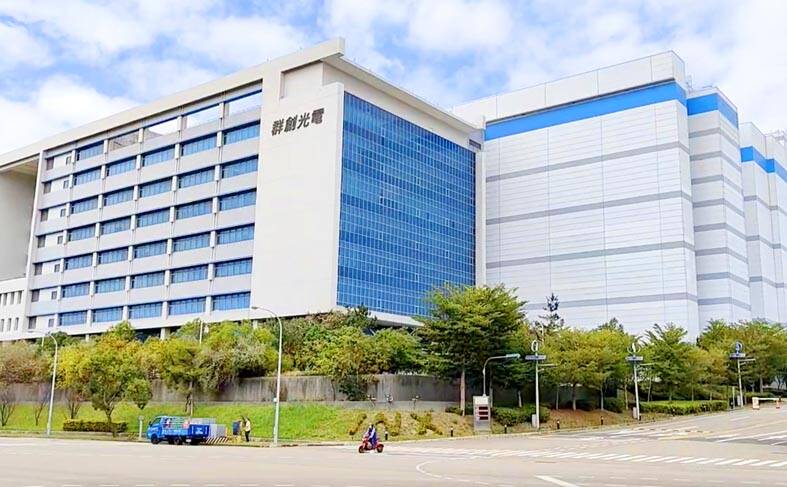Innolux Corp (群創) swung into a net profit of NT$6.47 billion (US$196.3 million) last year from a loss of NT$18.64 billion the previous year, which the flat panel display maker attributed to massive asset disposal gains.
The company booked a non-operating income of NT$16.15 billion last year, derived from gains of NT$14.7 billion from selling an idled plant in Tainan to Taiwan Semiconductor Manufacturing Co (台積電).
Earnings per share improved to NT$0.76, compared with losses per share of NT$2.01 in the prior year, Innolux said.

Photo courtesy of a reader via CNA
Using last year’s earnings and an allocation of the company’s reserved income, its board of directors approved a cash dividend distribution of NT$1 per share, it said.
Even so, Innolux has not steered out of the woods yet. The company reported a third consecutive year of an operating loss of NT$7.92 billion last year, following an operating loss of NT$18.71 billion the previous year.
Gross margin improved to 6.5 percent from 1.5 percent, and the margin of earnings before interest, taxes, depreciation and amortization (EBITDA) rose to 10.7 percent from 5.7 percent a year ago, the company said.
The company is positive about the flat panel market going forward, citing China’s subsidiary program for consumer electronics, which would stimulate replacement demand, and the US tariff hikes on imports, which are expected to prompt customers to front-load flat panels used in TVs and computers, Innolux said.
The introduction of new artificial intelligence (AI) models from DeepSeek (深度求索) is also accelerating the adoption of AI devices and applications, buoying up demand for computer flat panels, it added.
Shipments of large-sized panels used in TVs and computers are to drop by a low-single-digit percentage this quarter from last quarter, while shipments of small-and-medium-sized panels are to increase by a low-single-digit percentage sequentially, the company said.
To minimize the impact of the industry’s boom-and-bust cycles, Innolux has strived to expand into the advanced chip packaging, or panel-level packaging (PLP) technology, business.
However, disappointing demand for smartphones has delayed the company’s PLP product shipments from the end of last year it had scheduled, it said.
The company said non-display products contributed about 26 percent to the company’s total revenue during the final quarter of last year, up slightly from 24 percent in the same period of 2023. Display products made up 74 percent last quarter, down from 76 percent a year earlier.

TAKING STOCK: A Taiwanese cookware firm in Vietnam urged customers to assess inventory or place orders early so shipments can reach the US while tariffs are paused Taiwanese businesses in Vietnam are exploring alternatives after the White House imposed a 46 percent import duty on Vietnamese goods, following US President Donald Trump’s announcement of “reciprocal” tariffs on the US’ trading partners. Lo Shih-liang (羅世良), chairman of Brico Industry Co (裕茂工業), a Taiwanese company that manufactures cast iron cookware and stove components in Vietnam, said that more than 40 percent of his business was tied to the US market, describing the constant US policy shifts as an emotional roller coaster. “I work during the day and stay up all night watching the news. I’ve been following US news until 3am

UNCERTAINTY: Innolux activated a stringent supply chain management mechanism, as it did during the COVID-19 pandemic, to ensure optimal inventory levels for customers Flat-panel display makers AUO Corp (友達) and Innolux Corp (群創) yesterday said that about 12 to 20 percent of their display business is at risk of potential US tariffs and that they would relocate production or shipment destinations to mitigate the levies’ effects. US tariffs would have a direct impact of US$200 million on AUO’s revenue, company chairman Paul Peng (彭雙浪) told reporters on the sidelines of the Touch Taiwan trade show in Taipei yesterday. That would make up about 12 percent of the company’s overall revenue. To cope with the tariff uncertainty, AUO plans to allocate its production to manufacturing facilities in

Six years ago, LVMH’s billionaire CEO Bernard Arnault and US President Donald Trump cut the blue ribbon on a factory in rural Texas that would make designer handbags for Louis Vuitton, one of the world’s best-known luxury brands. However, since the high-profile opening, the factory has faced a host of problems limiting production, 11 former Louis Vuitton employees said. The site has consistently ranked among the worst-performing for Louis Vuitton globally, “significantly” underperforming other facilities, said three former Louis Vuitton workers and a senior industry source, who cited internal rankings shared with staff. The plant’s problems — which have not

COLLABORATION: Given Taiwan’s key position in global supply chains, the US firm is discussing strategies with local partners and clients to deal with global uncertainties Advanced Micro Devices Inc (AMD) yesterday said it is meeting with local ecosystem partners, including Taiwan Semiconductor Manufacturing Co (TSMC, 台積電), to discuss strategies, including long-term manufacturing, to navigate uncertainties such as US tariffs, as Taiwan occupies an important position in global supply chains. AMD chief executive officer Lisa Su (蘇姿丰) told reporters that Taiwan is an important part of the chip designer’s ecosystem and she is discussing with partners and customers in Taiwan to forge strong collaborations on different areas during this critical period. AMD has just become the first artificial-intelligence (AI) server chip customer of TSMC to utilize its advanced